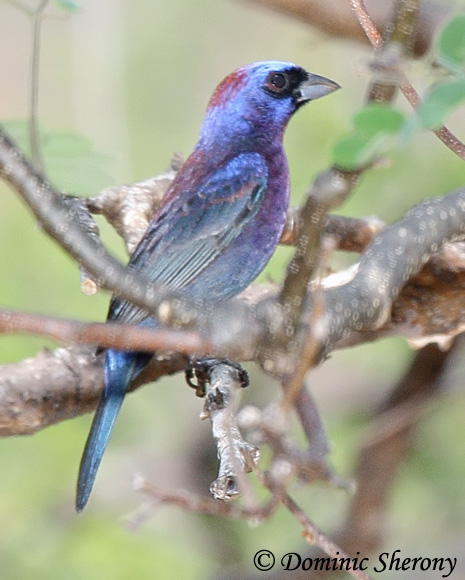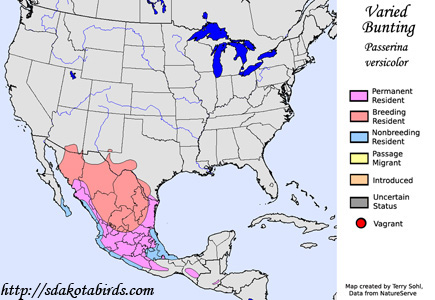| Length: 5.5 inches | Wingspan: 7.75 inches | Seasonality: Non-resident in South Dakota |
| ID Keys: Males dark overall, red nape, deep bluish face and rump. Female plain, light brown. | ||
 The
Varied Bunting is a beautifully colored bird of Mexico and Central America,
with a range that just crosses into the United States in southern Texas,
Arizona, and New Mexico. The beautifully colored males often appear
dark, even almost black, until seen in lighting that highlights their
beautiful iridescent plumage. They live in dense shrubby thickets, but
are not shy of humans. When males are singing in the summer, they are
often quite approachable.
The
Varied Bunting is a beautifully colored bird of Mexico and Central America,
with a range that just crosses into the United States in southern Texas,
Arizona, and New Mexico. The beautifully colored males often appear
dark, even almost black, until seen in lighting that highlights their
beautiful iridescent plumage. They live in dense shrubby thickets, but
are not shy of humans. When males are singing in the summer, they are
often quite approachable.
Habitat: Found in areas of thick brushy vegetation or dense undergrowth of open forests, especially in brushy canyons along rivers and streams.
Diet: Feeds heavily on insects and spiders during the summer breeding season. Also feeds on seeds, fruits, and berries, especially during the winter months.
Behavior: Usually forages relatively close to the ground in shrubs and bushes and relatively low in trees, as well as on the ground itself. During the summer months they typically are solitary when foraging, but in winter they sometimes form small flocks.
Nesting: The nest of a Varied Bunting is a cup of grasses, weeds, and spider webs, lined with plant down or other softer material. It is placed in dense shrubbery or a small tree, generally within 10 feet of the ground. The female alone incubates the eggs, but both parents help to feed and raise the young. They often will nest more than once in a breeding season.
Song: The song of a Varied Bunting is a variable warbling.
Feeders: Will attend feeders for sunflower seeds and millet. They will also sometimes sip sugar water from hummingbird feeders.
Migration: A relatively short-distance migrant. Most birds in the northern portion of their range move south into Mexico for the winter, although some do overwinter in southern Texas. Birds in much of their Mexican and Central American range are non-migratory.
Interactive eBird Map: Click here to access an interactive eBird map of Varied Bunting sightings
Similar Species: Indigo Bunting, Painted Bunting
Conservation Status: Populations have declined in many areas due to habitat loss, but the Varied Bunting is still locally common in suitable habitat in its range. The IUCN lists the Varied Bunting as a species of "Least Concern".
Further Information: 1) Wikipedia - Varied Bunting
2) WhatBird - Varied Bunting
3) Audubon Guide - Varied Bunting
Photo Information: Photo by Dominic Sherony - April 25th, 2011 - Guatemala - Photo licensed under Creative Commons Attribution ShareAlike 2.0 License.
| Click below for a higher-resolution map |
 |
| South Dakota Status: Non-resident in South Dakota |
Additional Varied Bunting Photos (Coming Soon!)
